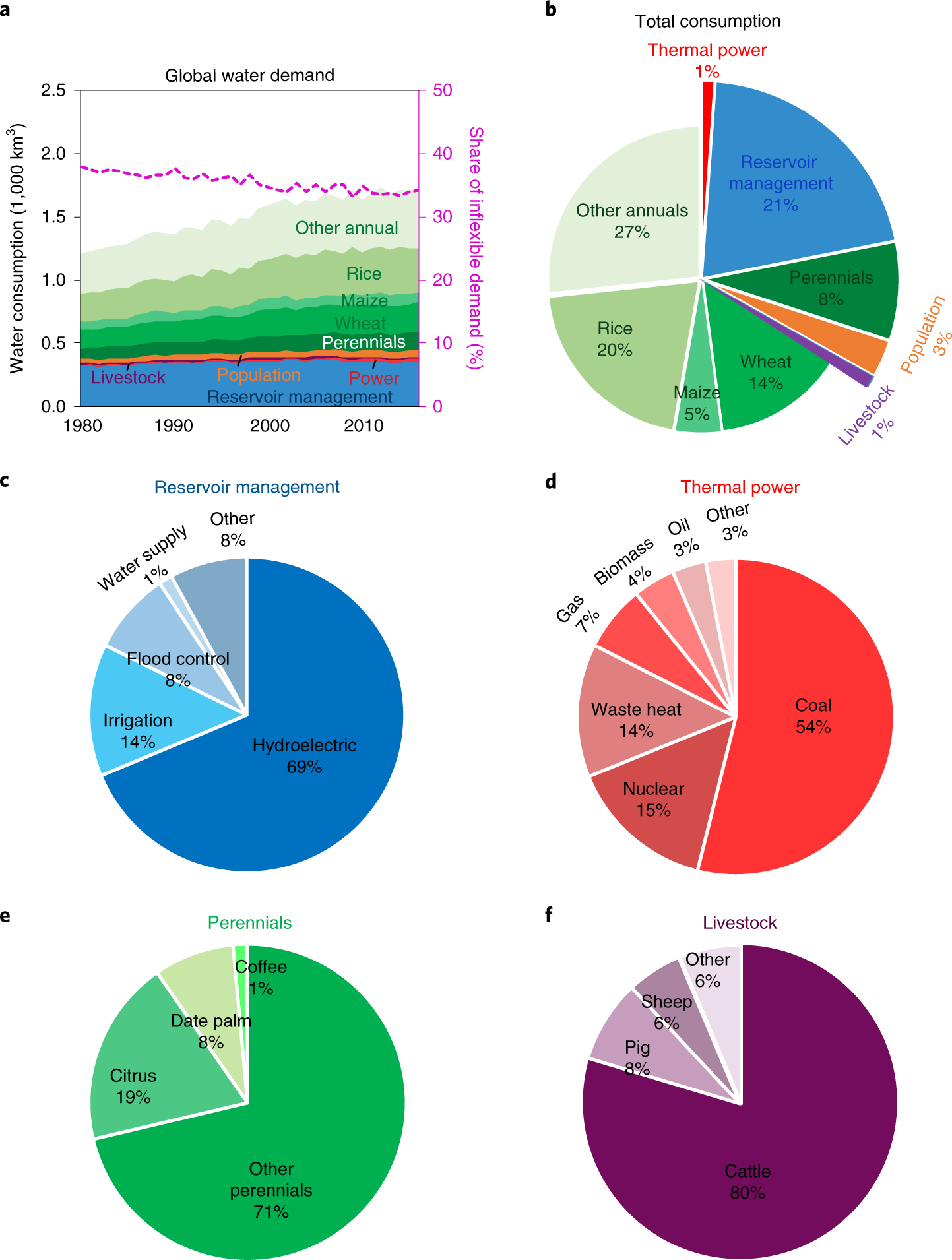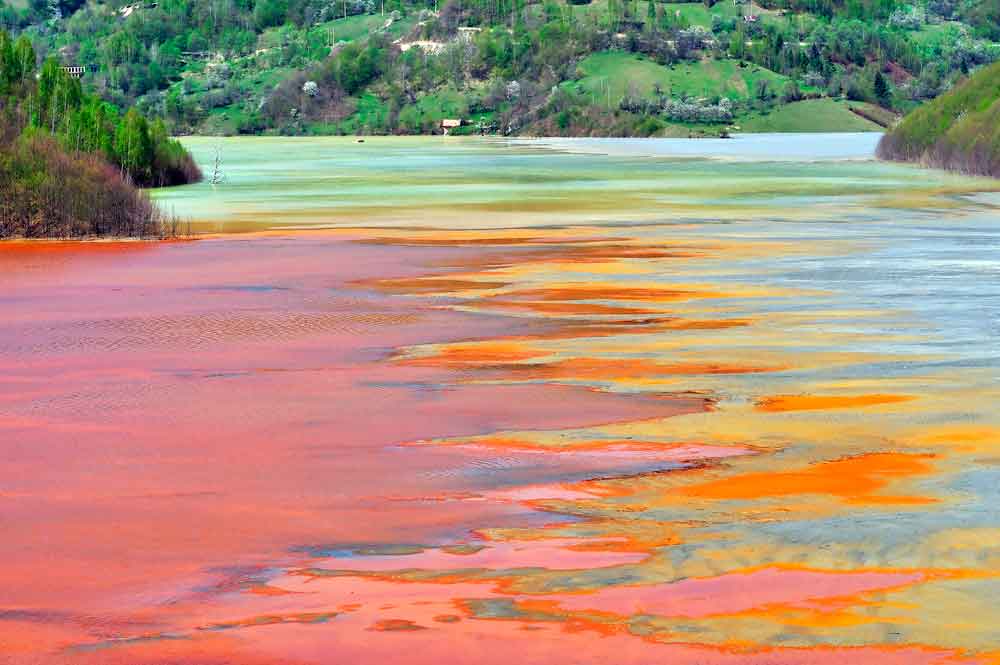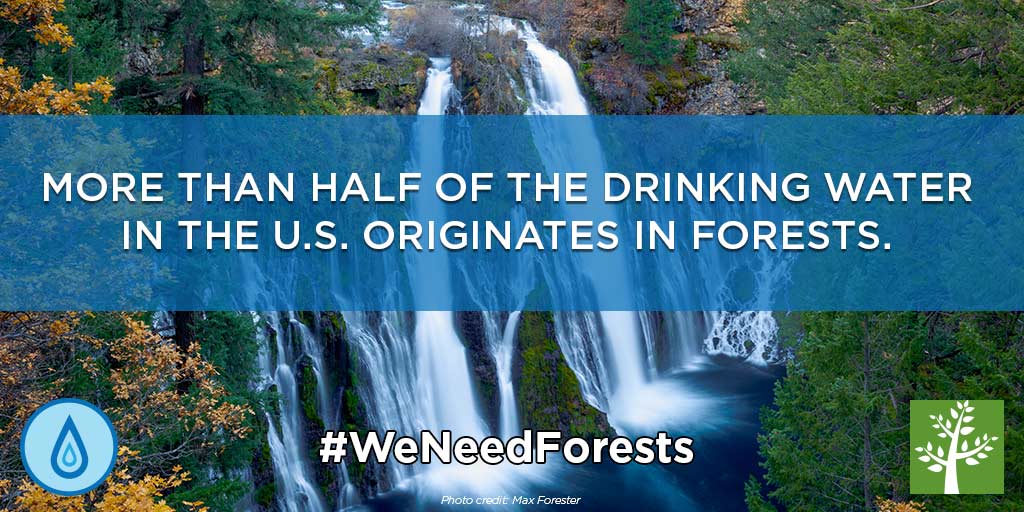70% of the fresh water used by people is used to grow food. As can be seen from this 2019 graph (Qin et al.), agricultural grasses consume the lion's share of fresh water; rice alone accounts for 20% of freshwater resources used by humanity, followed by wheat at 14% and maize at 5%, with all other annuals accounting for 27% of use. Livestock accounts for 1%, but this does not include the water to grow feed nor the polluted water that results from stockyard runoff. Thermal power production consumes just 1% of fresh water, however reservoir management consumes 21%, and this includes the hefty chunk (more than 2/3 of that 21%) that is used to generate hydroelectric power.

Running water through turbines is not itself consumptive of water, but the massive dams that have been constructed to facilitate power generation and to create reservoirs to hold irrigation water - which accounts for 14% of the water used in reservoir management - have consequences for downstream ecosystems. They can also worsen geopolitical conflicts in situations where enemy nations share a river basin. India and Pakistan have experienced ongoing violence over the Kashmir region, and the waters of the Ravi River are a pawn in this struggle. The Mekong River has its headwaters in China, and flows through five countries in Southeast Asia – China has already dammed it eleven times (Hutt, 2019). With the power to divert the flow entirely, China has the ability to threaten rice irrigation in several countries.

If there are water wars, it is likely to be due to dams across rivers that slow the flow of water across borders, the exhaustion or pollution of shared aquifers, or attempts to privatize water such that consumers can no longer afford water they need to grow food and run their households. Water can also be a weapon of conflict, as can any necessary resource – cutting off the enemy's access to supplies was the point of an old-fashioned siege. Destruction of water resources can also be an indirect result of conflict; war is filthy.
Imagine having no running water, no sewer connection, and to be legally required to pay a private company to use a well you've already dug. Imagine, instead of turning on a tap, buying contaminated water off a truck every day, which could cost almost half of the money you make (see Cochabamba, Bolivia, where a foreign corporation was physically thrown out of town). Imagine if it was illegal to collect the rain. Why would this happen? Corrupt public officials can make money selling of public assets to private companies, which then sell monopolized resources back to a desperate public at inflated prices; or, the World Bank and the IMF can make water privatization a condition of loans they make to developing governments (Collier, 2015). This can lead to misery, public unrest, and in some cases riots. In the U.S., local governments grappling with aging, leaky infrastructure can also be tempted to privatize city water systems (to varying degrees – a typical model is the PPP, or public-private partnership) just to raise the huge amount of capital it takes for massive restoration projects, and it doesn't always go as planned (see Atlanta City, where a privatized water system was returned to government control).

Water riot in Detroit. https://www.aljazeera.com/mritems/imagecache/mbdxxlarge/mritems/images/2014/7/22//2014722165452669734_20.jpg
Lakes, shorelines and rivers create wetlands where the water meets the land in an incredibly fertile overlap where nutrient-rich silt drops out of slow-moving water on flood plains, tidal flats, and estuaries. Dams hold this silt back, interfere with natural flooding cycles, prevent aquatic life from passing across them in many cases, and generally impoverish the wetlands that the rivers feed. Wetlands are a nursery for birds and fish, protect shorelines from storm surges, store water during wet times of year that are released in the summer to nurture aquatic life, sequester massive amounts of carbon if left undisturbed, and, most of all, naturally purify water as it slowly moves through their soils and vegetation. A threat to rich estuarial zones is eutrophication, and wetlands can help absorb the excess nutrients that tend to concentrate at the mouths of rivers or in lakes due to fertilizer runoff from farms (Paludan et al, 2002).

https://www.dailynews.lk/sites/default/files/news/2018/02/27/z_p11-Protecting.jpg
The marshland formed at the mouth of the Tigris and Euphrates rivers in Iraq has long been the home of an ancient civilization and was probably the site of the mythical Garden of Eden, but it was drained by Saddam Hussein to punish political enemies. After the wetland was partially restored (after every living thing was reduced to dust), water levels again started to fall and became too salty – thanks to a 60% reduction in river flow due to dam construction by Turkey and Iran (Schwartzstein, 2015). Half of the world's wetlands have already been destroyed, but the loss of this World Heritage Site in Iraq was like losing humanity's homeland. Hopefully it can recover - but what of the other magical places where floods kiss the earth with an explosion of life, with deep, rich soil, and with protection from the rage of the sea? As these ecosystems are needed more than ever to handle increased pollution loads, protect land from increasingly severe typhoons, and shelter breeding shorebirds, fish and shellfish at a time when habitat loss and overfishing are resulting in dwindling populations, wetlands are also more threatened than ever by clearing for farming and dams.

Iraqi Marshes, before and after drainage. https://science.sciencemag.org/content/sci/307/5713/1307/F2.large.jpg
And what about water that is exported within food and consumer goods like cotton, moving hidden inside imports from one part of the world to another? Is it fair for wealthy and water-rich countries to buy cheap clothes made from water-intensive cotton cultivation and cloth dying from impoverished, water-poor regions (in part because the labor's cheap)? And it's not just consumption that's the problem; according to Fluence, "It is estimated that 20% of industrial water pollution worldwide is associated with garment manufacturing, and 85% of that is associated with the fabric dying process" (Fluence News Team, 2018).

I feel that the issues presented here only scratch the surface of challenges to freshwater availability. Glacier and snowpack-fed water sources are threatened by climate change. Aquifers are being depleted by water bottling companies. Improvements in water-efficient agriculture are helpful, as are water treatment techniques that rely on microbes, plants, bivalves and fish. Still, forests are still being clearcut or burned to make room for agriculture and development - these micro-climate-generating natural water treatment "plants" are perhaps the key to the protection of our watersheds. When rainforests are cleared, they don't grow back – they are replaced with savannah. It turns out that not only do these forests need the rain, they also generate it, and when they're gone the land dries out. There is a tipping point past which the remaining rainforests no longer generate the microclimate they need to survive (Amigo, 2020).
https://www.americanforests.org/wp-content/uploads/2016/04/Water1.jpg
To make a very long story short: if humanity wants to protect freshwater resources, we should change the way we use dams, protect and restore wetlands (in part by allowing rivers to return to natural flow and flood patterns), protect forests, and plant trees. Changing the way we grow food from using irrigated monocultures to urban agriculture and Permaculture would have a huge positive impact. We need to recycle our greywater, replace our lawns with gardens and native species, and protect our waterways from polluted stormwater and agricultural runoff. And I haven't even told you about rain gardens yet – here's a blog about making one: https://trulyhouseraingarden.blogspot.com/

I made this rain garden at the Cascadia College/University of Washington campus in 2019 - you should see it in the summer, it's full of trees taller than I am now!
References
Amigo, I. (2020, February 25). When will the Amazon hit a tipping point? Retrieved April 8, 2020, from https://www.nature.com/articles/d41586-020-00508-4
Collier, V. (2015). Corrupt water privatization schemes: U.S. Citizens mobilize against corporate water grabs. Retrieved April 8, 2020, from https://www.globalresearch.ca/corrupt-water-privatization-schemes-u-s-citizens-mobilize-against-corporate-water-grabs/5430999
Fluence News Team. (2018, November 5). The water footprint of the blue jean. Retrieved April 8, 2020, from https://www.fluencecorp.com/blue-jeans-water-footprint/
Hutt, D. (2019). Water war risk rising on the Mekong. Retrieved April 8, 2020, from https://asiatimes.com/2019/10/water-war-risk-rising-on-the-mekong/
Paludan, C., Alexeyev, F. E., Drews, H., Fleischer, S., Fuglsang, A., Kindt, T., … Wolter, K. (2002). Wetland management to reduce Baltic Sea eutrophication. Retrieved April 8, 2020, from https://www.ncbi.nlm.nih.gov/pubmed/12079128
Schwartzstein, P. (2015, July 9). Iraq's Famed Marshes Are Disappearing-Again. Retrieved April 8, 2020, from https://www.nationalgeographic.com/news/2015/07/150709-iraq-marsh-arabs-middle-east-water-environment-world/#close
Qin, Y., Mueller, N. D., Siebert, S., Jackson, R. B., Aghakouchak, A., Zimmerman, J. B., Tong, D., Hong, C., Davis, S. J. (2019). Flexibility and intensity of global water use. Nature Sustainability, 2(6), 515–523. doi: 10.1038/s41893-019-0294-2

No comments:
Post a Comment